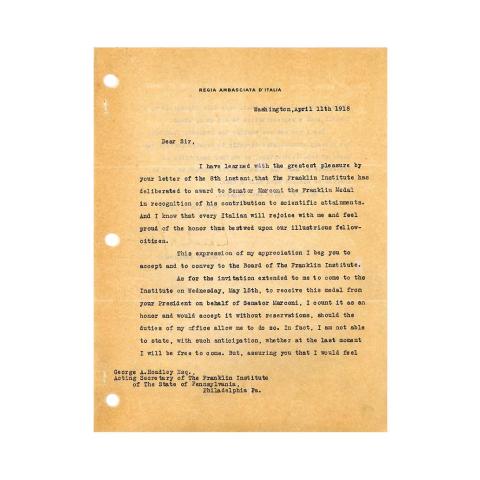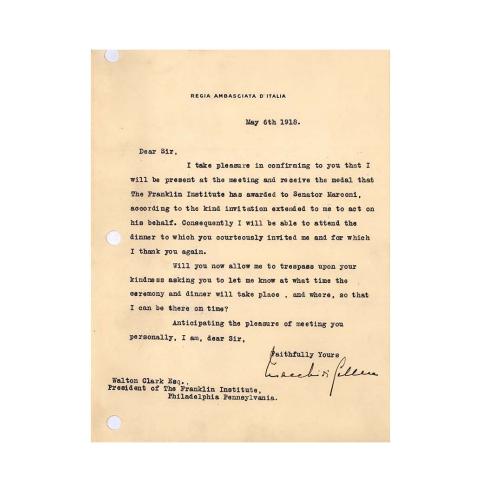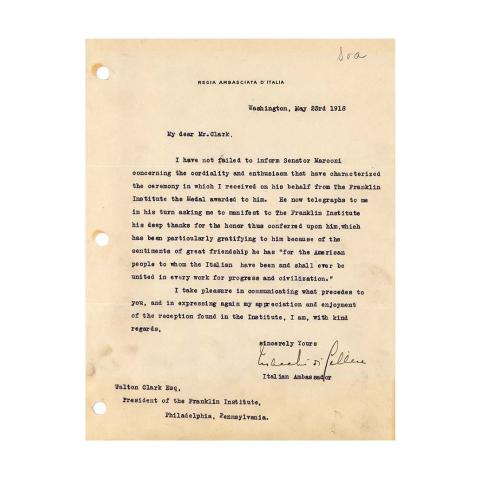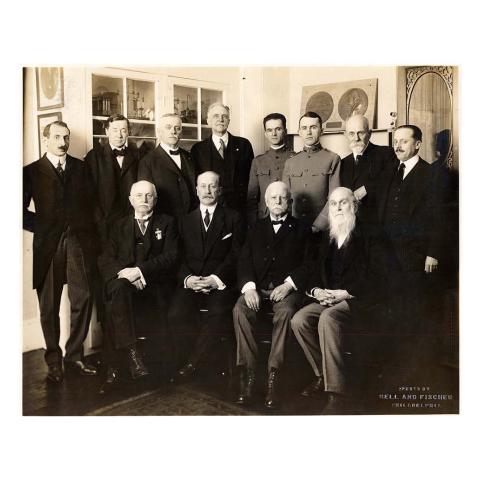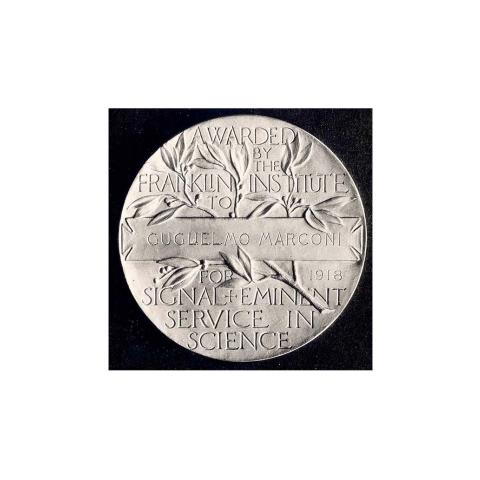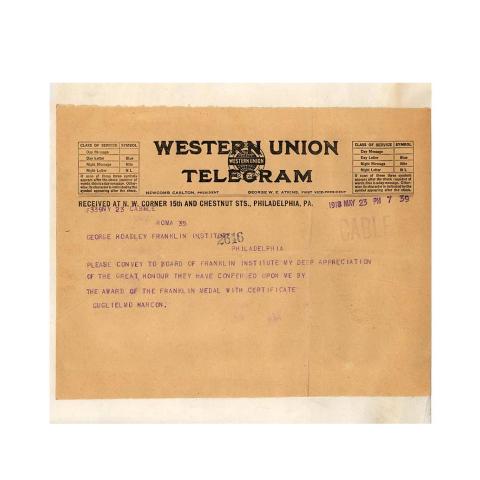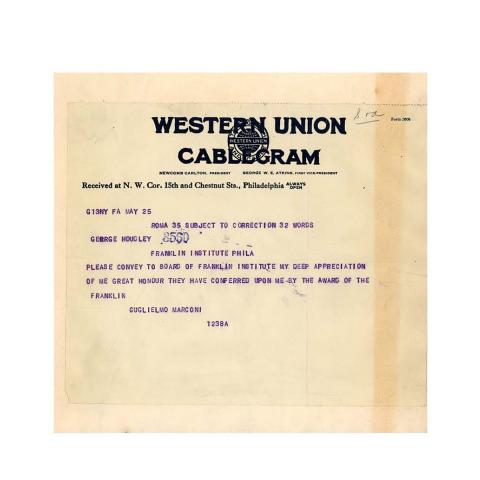
Introduction
With a knack for mechanical tinkering, Guglielmo Marconi had built his first telegraph transmitter by age 16. As a gifted amateur, Marconi had a wireless transmitter that could span 2,000 meters by age 21. This extraordinary young scientist would go on to make the world a smaller place. With wireless communication, distant lands became closer.
Just who was Guglielmo Marconi? How did he adapt Hertz's discovery of radio waves to his own work? And how did Marconi's determination and perseverance factor into his success with wireless telegraphy?
Beyond Visual Range
Marconi first approached the Italian Ministry of Posts and Telegraphs to demonstrate the advantages of his wireless method versus the existing system of land-based cables and met with no success. Switching his attention to the United Kingdom, Marconi used his family connections in London who put him in contact with British experts, who in turn introduced him to Dr. William Preece, Chief Engineer of the General Post Office. Preece, who had himself been experimenting with alternative transmission methods, was very cooperative and helpful. He offered Marconi any necessary working space and assisted at the first public demonstration of wireless telegraphy. During this time, work was proceeding on the patent application titled "Improvements in Transmitting Electrical Impulses and Signals, and an Apparatus therefore." The patent was filed on June 2, 1896, and finally published as British Patent No.12039 on March 2, 1897. In July 1896, the transmission range had grown to 400 meters and newspapers had published news of the discovery to wide acclaim.
Trials were made which demonstrated the efficiency and dependability of wireless transmission across open water, opening up the possibility of dispensing with underwater cables. Observers from the maritime services were impressed; up to that time communication between ships at sea was limited to visual signals, either semaphore flags or signal lights that could be obliterated by fog. Now messages could be transmitted beyond visual range.
Among the audience were observers from Italy who now reversed themselves and asked that Marconi demonstrate his invention in his native land. The result showed successful transmission from La Spezia Naval Base over 18 kilometers to a ship at sea; the barrier of communication over the horizon to a receiver out of sight was surpassed in July 1897. Marconi, at the age of 23, was hailed as a national hero.
In 1897, the Wireless Telegraph and Signal Company, the forerunner of Marconi's Wireless and Telephone Company, was established in London and connections to the nationally owned General Post Office were ended.
Interested in learning more about Guglielmo Marconi? Learn More About His Benjamin Franklin Award
The Next Threshold
The next technical challenge was to increase the distance for transmission across seas and oceans. In December 1897, signals traveled up to 29 kilometers from a station on the Isle of Wight out to ferry boats in the English Channel, a locale know for treacherous weather conditions. On March 27, 1899, the bad weather was shown inconsequential as the first international transmission was made from South Foreland, near Dover, to the village of Wimereaux, near Boulogne. Now the navies of France, Britain, and the United States became very interested in the new technology and its strategic importance. Successful trials of ship-to-ship communication during maneuvers followed, and during the Boer War, which broke out in October of that year, ship-based wireless was put to valuable use.
At the turn of the century, the Marconi Company began to have some commercial success and the goal of passing the next threshold—transatlantic communication—was declared. This commitment was a daring undertaking for the young company but Marconi immediately pressed ahead. Land for the eastern station was found on a headland at Poldhu in the far southwest of England and land for the western station on a cliff-top near South Wellfleet on Cape Cod, close to the easternmost point in the United States. This arrangement provided a clear path for wireless transmission across the ocean. Work began on the powerful transmitters and enormous masts required for the project. A 25 kw power plant was built at Poldhu together with a system of 20 200-foot masts arranged in a 200-foot diameter circle. The same installation was built in Cape Cod. Before the systems could be tested, they fell victim to the fierce weather in their exposed locations: first the almost completed Poldhu aerial toppled and the masts at Cape Cod collapsed a month later. As usual, with Marconi's determination, rebuilding of a new, stronger aerial at Poldhu began immediately.
Another problem, that of signal interference, had to be overcome before transmissions across the ocean could be feasible. The high power necessary for longer range caused the signal to be diffused and interfere with other exchanges taking place between ships and shore. Marconi's patent number 7777 enabling selective wavelength tuning removed this problem.
Concerns grew about the signal power required for Poldhu-to-Cape Cod transmission, a distance of 4,000 km, and the decision was made to reduce this distance by moving the western terminal north to Newfoundland, Canada, an unimpeded 2,880 km from Poldhu. A station was built on Signal Hill, St. John's. On December 12, 1901, in the midst of a gale, with kites and aerials in danger of damage, Marconi detected and his assistant George Kemp confirmed the faint clicks of Poldhu's first transatlantic signal. This was an extremely memorable moment.
Marconi's success was celebrated in Canada and the United States. With financial incentives offered by the Canadian government, Marconi built his next, more powerful station in Glace Bay, Cape Breton. Transatlantic wireless service was established in December 1902.
A Critical Time
In March 1905, Guglielmo Marconi put his obsession with wireless aside long enough to marry the Honourable Beatrice O'Brien, a 19 year-old of Irish descent and impoverished circumstances. Their honeymoon at the family's Irish castle was shortened by Marconi's return to work. He planned to establish a new transatlantic station, with a 300 kw power plant at Clifden on the west coast of Ireland.
The year 1908 was a critical one for Marconi with his company facing a series of cash flow, litigation, and technical problems. In addition, his marriage was beset with tragedy and tension. His first daughter, Lucia, had died in infancy and his second, Degna, was born in the middle of the company's turmoil.
Yet again Marconi's determination came through. He assumed management of the company and restored its stability. Some personal satisfaction came in December 1909 with him being awarded the Nobel Prize for Physics.
Transatlantic Travels
Now the next frontier in wireless communication—air-to-ground transmission—was about to be reached. Trials involving transmitters and receivers in balloons had been ongoing but the first direct air-to-ground message was sent from a bi-plane overhead to a station on Long Island, New York. The first air-sea rescue followed as a Marconi operator was able to telegraph for help from the damaged airship America in mid-Atlantic.
The focus moved to South America and further records were set with transmissions from Buenos Aires to Clifden traveling 6,400 km in daytime. During this time, when he was in Buenos Aires, Marconi's son, Giulio, was born.
The Clifden-to-Glace Bay route became the dominant passage for the rapidly increasing transatlantic wireless traffic. Later upgrades to the stations at Poldhu and Cape Cod were made to supplement their operation.
The practical use of wireless telegraphy continued to be for ships at sea, both commercial and military. Most vessels carried Marconi operators to service the communications. The effect of speedy information on military tactics and strategy was profound with Britain, Italy, France, Germany, and the United States using the latest equipment. These flourishing developments sent Marconi traveling throughout the world.
Established Industry
Wireless telegraphy was now an established industry with Marconi's companies becoming profitable and the associated factors of commerce—competition and litigation—taking Marconi's time away from invention. Outstanding patent disputes were resolved and ongoing disagreements with the German company, Telefunken, were settled just months before the outbreak of World War I.
As an Italian citizen, Marconi remained in England in 1914 but returned to Italy in 1915 to wartime service in the army, navy, and ultimately, the diplomatic corps. After the war, in 1919, Marconi purchased a large steam yacht, the Elettra, which became his laboratory and a floating home. His newest topics were the possibilities of short-wave radio, sonar detection, and microwave transmission. His faltering marriage finally ended in 1924 and in 1927 he married the much younger Maria Cristina Bazzi-Scali, a descendent of Vatican aristocracy. His third daughter, Elettra, was born in July 1930.
Illness struck Marconi in 1927 with his first of four heart attacks that kept him weak and confined to care in Rome for a number of years. Recovering in 1933, Marconi took a round-the-world trip with his wife and at every stop found himself celebrated and honored.
His dedication to his work—on microwaves, "blind" navigation, and the promise of radar—continued until his death. He died in Rome on July 20, 1937. On July 21, the day of his funeral, radio operation throughout the world was silent for two minutes to honor its foremost inventor.
Landline Telegraphy
Telegraphy has three elements: a transmitter, a receiver, and a conducting medium.
In landline (cable) telegraphy, the originating message is encoded at the transmitter in the Morse code using a system of interrupted electric current. The receiver detects the series of interruptions and, via an electromagnet, converts them to audible clicks that reflect the coded message. The operator then translates the click patterns to Morse code equivalents and then to the original message.
Landline telegraphy relies on wire (cable) to carry the pulsed electric signals, a method limited by the distance and terrain cable can cover.
Electromagnetic Radiation
Heinrich Hertz experimentally confirmed Maxwell's prediction of electromagnetic radiation traveling at the speed of light. His Oscillator (transmitter) used the electric charge from a Leyden jar to create a spark between conductors and powerful electrical waves in the area around the spark.
The Hertz Resonator, consisting of separated conductors attached to copper sheets, completed the experiment by detecting radiation through the air from the sparking Oscillator. The quick electric surge of each spark created a changing electromagnetic radiation that induced an electric current in the Resonator.
Basic Wireless Telegraphy
In wireless telegraphy, the conducting medium is not wire but simply air. The transmitting antenna radiates the electromagnetic field created by the originating current from the spark coils—at the speed of light in every direction. This signal is then available to any receiving antenna within its range.
A receiving antenna reverses the process, converting the airborne electromagnetic radiation it detects to an electric current which is translated at the receiving station.
Morse Key
The Morse key consists of a hand-operated electrical switch, a battery, and a receiver, called a sounder. Both sending and receiving circuits are grounded.
Pressing the key (switch) at the sending location sends an electric current to the antenna. The signal is picked up by the receiving antenna and electric current is sent to the sounder. At the sounder, the current magnetizes a hinged tab that connects to another with a loud click. Release of the sending key discharges the magnets and the hinged tab springs away, causing another click.
An experienced operator can send a Morse code "dot" with a quick key strike (causing two close clicks) or a long key depression for a "dash" (two more separated clicks). The transmitted message is "read" by discerning the "dots" and "dashes" and translating the code.
Improving Wireless Telegraphy
The road to improving wireless telegraphy involved: (1.) strengthening and refining the transmitted signal and (2.) increasing the sensitivity of the detecting apparatus.
The strength of the sending signal was mostly dependent on the power of the spark source. Marconi built power plants with increasing capacity, reaching 25 kW at his Poldhu station. Parabolic reflectors were used to concentrate and redirect the signal. Increasingly high, precariously located antennas were installed in the mistaken belief that antenna height exponentially increased signal transmission distance. The steel masts at the Poldhu station were 250 ft high.
The Branly coherer was the first instrument used to detect radio signals. It relied on the phenomenon that loose metal filings will merge and become a conductor in the presence of a weak electric current caused by radio waves. The coherer consisted of a glass tube containing nickel and silver filings with terminals fused into each end of the tube. A hammer arrangement was also attached to disrupt the metal after each passage of current, making it ready to react to the next signal received. Marconi built on the coherer principle to build and patent increasingly sensitive magnetic detectors.
Marconi Magnetic Detector
Marconi's magnetic detector, nicknamed the "Maggie," consists of a continuous iron band moving through a glass tube to which permanent magnets are attached. The tube is spirally wound with insulated copper wire; the wire terminals of this primary coil are connected between the antenna and a grounded connection. A secondary coil of insulated wire is wound on a spool which surrounds the primary; its wires are connected to headphones.
In the detector's operation, each section of the iron band is magnetized as it passes the permanent magnets and moves on. When each radio signal reaches the primary coil, the magnetism in the passing iron band changes. The changing magnetism induces a current in the secondary coil, resulting in a clicking sound in the earphones.
Acknowledgement
In 1918, Guglielmo Marconi was awarded the Franklin Medal in Engineering for "the application of radio waves to communication."
Count V. Macchi de Celere, "Ambassador Extraordinary and Plenipotentiary of His Majesty the King of Italy," accepted the Franklin Medal on Marconi's behalf at the Award ceremony in May 1918.
Thomas C. Mendenhall also received a Franklin Medal that year—in Physics—for "contributions in the field of physical research and contributions to our knowledge of physical constants and electrical standards."
Credits
The Guglielmo Marconi presentation is made possible by support from The Barra Foundation and Unisys.
This website is the effort of an in-house special project team at The Franklin Institute, working under the direction of Carol Parssinen, Senior Vice-President for the Center for Innovation in Science Learning, and Bo Hammer, Vice-President for The Franklin Center.
Special project team members from the Educational Technology department are:
Karen Elinich, Barbara Holberg, Margaret Ennis, and Jay Treat.
Special project team members from the Curatorial department are:
John Alviti and Andre Pollack.
The project's Advisory Board Members are:
Ruth Schwartz-Cowan, Leonard Rosenfeld, Nathan Ensmenger, and Susan Yoon.
Read the Committee on Science and the Arts Report on awarding of The Franklin Medal to Guglielmo Marconi.


